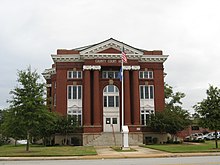Newberry County, South Carolina
| Newberry County, South Carolina | |
|---|---|

Newberry County Courthouse
|
|
 Location in the U.S. state of South Carolina |
|
 South Carolina's location in the U.S. |
|
| Founded | 1785 |
| Seat | Newberry |
| Largest city | Newberry |
| Area | |
| • Total | 647 sq mi (1,676 km2) |
| • Land | 630 sq mi (1,632 km2) |
| • Water | 17 sq mi (44 km2), 2.7% |
| Population | |
| • (2010) | 37,508 |
| • Density | 60/sq mi (23/km²) |
| Congressional districts | 3rd, 5th |
| Time zone | Eastern: UTC-5/-4 |
| Website | www |
Newberry County is a county located in the U.S. state of South Carolina. As of the 2010 census, its population was 37,508. Its county seat is Newberry. The name is of unknown origin.
Newberry County comprises the Newberry, SC Micropolitan Statistical Area
Newberry County was formed from Ninety-Six District in 1785. Prior to its formal founding, the area was the site of several American Revolutionary War battles: Williams' Plantation, Dec. 31, 1780; Mud Lick, March 2, 1781; and Bush River, May 1781.[3]The town of Newberry was founded in 1789 as the county seat and was sometimes called Newberry Courthouse for that reason.
Originally settled by yeomen farmers, in the nineteenth century numerous plantations were established for the cultivation of short-staple cotton. Its processing had been made profitable by invention of the cotton gin. Cotton was the primary crop grown in Newberry County before the American Civil War. Newberry was a trading town, and expanded with the arrival of the railroad in the early 1850s, which connected it to major towns and markets. Newberry College was established by the Lutheran Church in 1856.
The Civil War interrupted growth in the county; the warfare and loss of lives of many southern men disrupted the state economy. The first cotton mills were constructed in the county in the 1880s, and quickly became an important part of the economy and a source of jobs. With the mechanization of agriculture in the early 20th century, labor needs were reduced.
Since the 1970s the population of Newberry County has been growing due to increasing local economic prosperity.
According to the U.S. Census Bureau, the county has a total area of 647 square miles (1,680 km2), of which 630 square miles (1,600 km2) is land and 17 square miles (44 km2) (2.7%) is water.
As of the 2000 census, there were 36,108 people, 14,026 households and 9,804 families residing in the county. The population density was 57 people per square mile (22/km²). There were 16,805 housing units at an average density of 27 per square mile (10/km²). The racial makeup of the county was 64.02 percent White, 33.12 percent Black or African American, 0.28 percent Native American, 0.29 percent Asian, 0.09 percent Pacific Islander, 1.30 percent from other races, and 0.90 percent from two or more races. Some 4.25 percent of the population were Hispanic or Latino of any race.
...
Wikipedia
